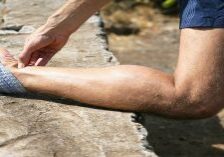Degenerative Disc Disease
13th November 2019Shin splints
22nd March 2020What is Spinal Stenosis?
Spinal Stenosis is a narrowing of the spaces in your spine which can lead to pressure on your spinal nerves that travel through the area.
The changes normally occur in your lower back and is therefore also called lumbar spinal stenosis.
What are the symptoms of Spinal Stenosis?
Typical symptoms you might experience are back, buttock or leg pains, along with leg symptoms of pins and needles or tingling, numbness, weakness or heaviness. You can get symptoms in one or both of your legs.
Typical symptoms tend to follow the following rules
- Symptoms are worse with standing or walking
- You feel better for sitting or bending forwards.
Who gets it?
The typical age group is men and women over 60. It is not common to get symptoms if you are younger than this.
What happens in Spinal Stenosis?
Ours spine is made up of bones (vertebrae) and discs held together by tough ligaments.
Down the middle of your spine runs the spinal cord and smaller nerves exit your spine through holes which are known as vertebral foramen.
Problems occur when degenerative changes lead to narrowing of the space for your nerves.
What are degenerative changes?
You have heard of the word osteoarthritis. In essence it means your joints getting older and osteoarthritis is the medical word for it.
The phrase 'degenerative changes' relates to a number of normal changes which occur in your spine with age. So just like your hair will go grey and your skin will go wrinkly. Your spine gets older too. This is totally normal and nothing to worry about.
Spinal Stenosis is where the degenerative changes are more advanced in an area. A combination of a disc bulge and the joint ligaments thickening can narrow the space for your nerves and can cause nerve compression symptoms including pain, tingling or weakness.
Neurogenic claudication occurs as a result of ischaemia (lack of blood) or mechanical compression of nerve roots. This mechanical compression of nerve roots can cause decreased impulse conduction. However, narrowing at multiple spinal levels may be necessary to cause such complications.
Do I need a scan for Spinal Stenosis?
A diagnosis is given if your symptoms fit the usual pattern above and can also be confirmed with an MRI scan. If your symptoms are severe, surgery may be considered. Remember though the surgery if for your leg symptoms not your back.
What is the best treatment for spinal stenosis?
The jury is still out. Those who have an operation often have a recurrence of symptoms 1-2 years down the line. Oxford University are currently running a research trial called the BOOST Study for people with lumbar spine stenosis. It stands for Better Outcomes for Older people with Spinal Trouble. It should answer the question.
Does spinal stenosis require surgery?
Sometimes, is the best answer to this question. The surgery is called lumbar decompression surgery and it involves making more space for the nerves.
What happens if Spinal Stenosis is left untreated?
Does it go away? Well the answer in terms of the structural changes in your spine is no, but your symptoms may be improved with exercise. Again, the jury is out. But it is definitely worth a try.
What can I do for Spinal Stenosis?
It is common for people with the symptoms to become less active. Unfortunately this leads to weakness and a lack of flexibility, which can make the symptoms worse. We can teach you exercises that will help:
- Build your strength and endurance
- Enhance your flexibility
- Improve your balance







